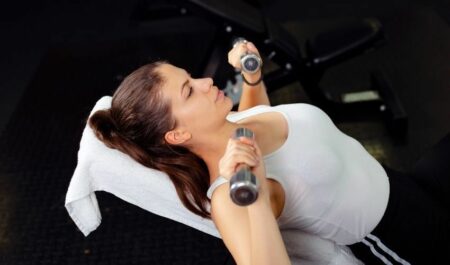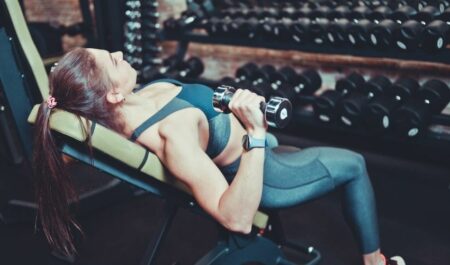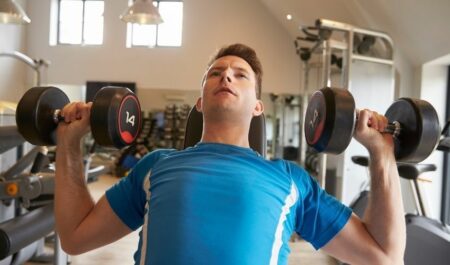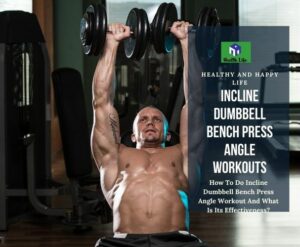The incline dumbbell bench press encompasses a wide array of exercises. It aims to build the chest and shoulder muscles. However, it engages different muscles depending on the variation exercise done. The incline dumbbell bench press angle plays a significant role in determining the muscles worked. As such it is important to adhere to the recommended bench angle when doing bench presses.
This article explores the incline dumbbell bench press and several of its variations. We educate you on the muscles exercised when you engage in these exercises. The article also highlights the recommended angles for bench press exercises and why they are considered best.
If you are looking to build your chest muscles and improve your strength, this article will educate you on how to do that.

Kindly keep reading to discover all the important details that will make your bench press exercise effective.
Heavy Dumbbell Press Incline Bench Angle
The incline bench press workout is among the top exercises for your upper chest. When working your chest you have to be very careful and knowledgeable about the exercises you partake. Ignorance in this case could lead either of the two dominant chest muscles to overpower the other.
The two main chest muscles are the anterior deltoids and the pectoralis major. If you don’t know the appropriate angle for the incline bench press you could over engage one muscle. You don’t want that to happen.
The appropriate incline dumbbell bench press angle varies depending on the muscles you want to target with your workout. The type of exercise also matters a lot. The perfect angle for an incline dumbbell fly, for example, would be 30-45 degrees.
Normally, the incline dumbbell bench press angle is supposed to range between 30 and 45 degrees. A wider angle helps you engage and work your anterior deltoid muscles.
When you adjust the bench to a 45-degree angle, for example, you will hit your anterior deltoid muscles. A 30-degree angle, on the other hand, will engage and work your upper pecs more.
What Angle Should My Bench Be For Incline Dumbbell Press?
An incline bench press is a must-include workout for your routine. If you adjust the angle so that you are seated in an almost upright position, you will engage your upper pecs. The result of this exercise on your upper pecs is unmatched.
When you thrust your hands overhead, you reduce the clavicular part of your pecs. As such, a larger incline engages the muscles on top of your pec and those on your deltoids.
The recommended upright angle should range between 15 and 30 degrees. If you set it any higher you may engage the wrong muscles and injure your shoulders in the process. Some people, however, say that 45 degrees is the best angle.
You will have to experiment with different angles to discover the most comfortable one for you. Remember not to increase the angle too much, as you would work on the wrong muscles.
Incline Dumbbell Bench Press Best Angle
The best incline dumbbell bench press angle should be the one that feels most comfortable for you. If you are comfortable, then you can carry out the routine effectively to achieve desired results. The recommended angle ranges between 30 and 45 degrees. As such, when experimenting to figure out the angle that works best for you, do not exceed these boundaries.
If the angle is not right, you may end up working the wrong muscles and possibly damaging your shoulders. It is important to observe the weight of the barbell to ensure that you are comfortable.
What Is The Difference Between Incline and Decline Bench Press?
While the incline bench press trains your upper pecs, the decline bench press focuses on your central and lower pecs. The incline version of this exercise works out your deltoids and shoulder joints. The decline bench press, on the other hand, concentrates on your chest.
When doing the decline bench press it is best to avoid the false grip as the bar could fall on your neck. Unlike the incline bench press, the bench for the decline comes already set. As such, you don’t need to adjust its angle. If you are using an adjustable decline bench, experiment with it to see what angle works best for you.

It is important to have a spotter help you with the barbell. If you have no spotter, keep safe by using dumbbells instead.
What Muscles Can Target From Incline Bench Press Angle?
The Incline Bench Press targets the muscles on your chest and shoulders. This free weight workout is designed to focus on your pectoral muscles and the muscles in front of your shoulders. The incline dumbbell pullover targets your lats and chest muscles, namely latissumus dorsi and pectoralis major.
The exercise supports a wide range of motion to provide a deep stretch of your pectorals and lats. When performed accurately and regularly, the exercise contributes to increased muscle growth in your upper chest. Besides giving you more muscles, the incline dumbbell press functions to increase the strength and size of your chest.
It is a well-rounded strength training exercise that effectively engages your chest and shoulders for increased muscle growth. You want to include the incline dumbbell press into your workout.
If you have strength imbalances, this exercise would effectively correct and balance the strength on each side of your body. The incline dumbbell row is also great for correcting strength imbalances. Incorporating dumbbells into this exercise ensures that each arm exercises independently. As such, the dormant hand does not take control of the lift.
What Are the Pros and Cons From This Angle Workout?
The main benefit of the incline press workout is to build the upper part of your pectoral muscles. If you set the bench at an angle ranging between 15 and 30 degrees, you engage your shoulder muscles intensely. At this angle, this workout is almost similar to the shoulder press exercise. The incline dumbbell hammer curl is a great workout to incorporate into your sessions.
It targets and engages the brachialis and brachioradialis, which are both secondary muscles. These muscles would be difficult to reach otherwise.
Another advantage of the incline bench press is attributed to the fact that it is a strength training exercise. It also plays a major role in engaging your heart muscles. As such is it a great cardio exercise. On the downside, the inclined bench press functions by intensely stressing your upper pecs. As a result, it further defines this muscle group.
It would be better if it built mass over the whole pec. The incline dumbbell hammer curl is great for increasing strength and building muscle mass around your biceps.
30 Or 45 Degree Incline Bench
The angle of inclination for your bench press exercise depends on the muscles you want to work on. When you adjust the bench to a 45-degree angle, for example, you will hit your anterior deltoid muscles. A 30-degree angle, on the other hand, will engage and work your upper pecs more.
Besides the fact that the angle of the bench determines the muscles worked, this angle varies significantly from person to person. As such, it is advisable to experiment with different angles to choose the one most suitable for you. In general, however, always set your bench somewhere in between 30 and 40 degrees.
When the angle is wider, it will enable you to work more on your shoulders. When you set it at 30 degrees you will largely engage your pecs.
What Age Groups More Effective?
Bench press exercises are effective in all age groups. The major difference across the various age groups is the results. The results can be very pronounced for people between 20 and 30 years old. You cannot expect the same results in people over 50. The issue here is not in the effectiveness of the exercise. It is in the execution and intensity of the exercise.

As you grow older, you become weaker, so you cannot compete at the same level of strength training with younger people. Regardless of age, bench presses are highly effective workouts. The results of your workouts, however, rely heavily on the input. As such, it may seem like bench presses are more effective in people in their 20s and 30s. However, that perception is inaccurate.
Is This Workout Can Do For Seniors?
Yes. Bench press exercises are some of the easiest workouts to do. In fact, they are more suitable for seniors because they do not require balancing. As such, elderly people are unlikely to lose balance and fall. Secondly, the person will be lying down. Therefore, it’s perfect for seniors with knee issues. The bench press is among the safest and most appropriate exercises for seniors.
As safe as it is, it is best to avoid engaging in this exercise if you have shoulder pain. It doesn’t matter how young you are. Keep of the bench press until your shoulder heals. As an elderly taking on bench press exercises, it is important to watch the weight of the barbell. Have a personal trainer to assist you hands-on throughout your workout or use a weighted rod that you can lift without help.
Difference between Barbell and Dumbbell Workouts
Both barbells and dumbbells are used in strength training exercises. Each of these equipment allows for a wide array of workouts. Although they have their differences, they also share some similarities. This means that depending on the target muscles and aim of the workout you can use one in place of the other.
Barbell Workouts Tend To Be More Strenuous Than Dumbbell Exercises.
You can incorporate a barbell into your workout routine if you aim to do heavy workout lifts. Dumbbells, on the other hand, are more suitable if you want to engage specific muscles. The incline dumbbell row, for example, is great for isolating lats. It is also an excellent choice for bodybuilders and people looking to build back strength.
Unlike dumbbells, barbells work on both sides simultaneously. With dumbbells, you have options. You can choose to engage in workouts that work one side at a time or both simultaneously. A great example of this is the incline dumbbell curls workout. You have a dumbbell in each hand and you lift them toward your chest in alternating motions. In most cases, however, you will find that you can use dumbbells to do exercise that would normally require a barbell.
Conclusion
There are many variations to the incline dumbbell bench press angle. For best results, choose the angle that works best for your workout. The most important detail to keep in mind is not to overload yourself with the weights. Choose weights that are appropriate for your strength.
Otherwise, you are likely to get muscle tears and possibly injure your shoulders or chest. Always make sure that you are fully capable of any exercise before taking it. If you are experiencing shoulder pains, for example, steer away from the exercise until you make full recovery.
Overall the dumbbell incline bench press is a safe workout, but you need to be strong enough to handle it. If you are a beginner, it is best to start slow and build your muscles before engaging in the advanced exercise.
